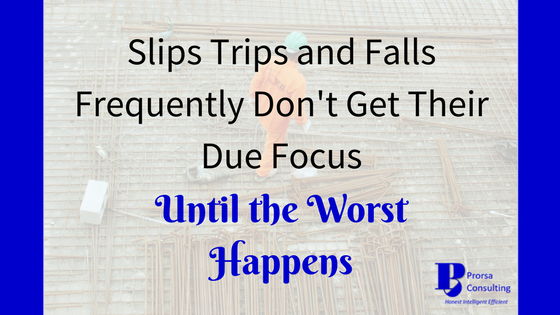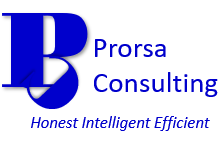Slips Trips and Falls Frequently Don’t Get Their Due Focus Until the Worst Happens
By : Admin -

How many times have you slipped, tripped, or fell in your life? For me and I would bet many others, I lost count a long time ago. However, some of us may not truly appreciate the potential danger slips trips and falls pose. Join me as we explore the statistics and prevention strategies for this sometime underrated safety hazard.
Slips Trips and Falls: The Accident Statistics
In 2016, the slips trips and falls category took third place on the Bureau of Labor Statistics (BLS) National Census of Fatal Occupational Injuries. Slips trips and falls resulted in approximately 16% of the fatalities in that year. Falls to a lower level accounted for 82% of the category’s resulting deaths.
As with transportation and workplace violence, which we covered in previous posts, slips trips and falls saw an increase in occurrences during 2016, according to BLS. The total occupational deaths from this accident category rose by 6% from the 2015 figures. Given these statistics, slips trips and falls need to be on every EHS professional’s radar.
What are the OSHA general industry regulatory obligations concerning slips trips and falls?
Occupational Safety and Health Administration’s (OSHA) regulations at 29 CFR 1910.21-30 (Subpart D) cover walking-working surfaces. Generally, employers are expected to ensure these areas stay clean and organized. In addition, OSHA mandates regulated entities to:
- Maintain surfaces in a dry state, to the extent possible
- Rid surfaces of hazards like leaks, spills, snow, ice, obstructive/protruding items, etc.
- Ensure the structural soundness of surfaces
- Allow for safe access and egress
- Inspect, maintain, & repair surfaces
- Train and retrain on the work hazards associated with walking-working surfaces
Subpart D also covers surface-specific requirements for items, such as ladders, stairways, scaffolds, etc. In addition, the regulation provides mandates on fall protection.
What standards associated with slips trips and falls cover metal/nonmetal mine sites?
Metal/nonmetal mine sites regulated by the Mine Safety and Health Administration (MSHA) must adhere to travelways and housekeeping regulations, which contain guidelines to prevent slips trips and falls. Travelways and housekeeping standards can be found at 30 CFR 56.11001-11027 (Subpart J) and 30 CFR 56.20003 (in Subpart S), respectively for surface mines. Underground metal/nonmetal mines follow the travelways/escapeways and housekeeping rules found in 30 CFR 57.11001-11059 (Subpart J) and 30 CFR 57.20003 (in Subpart S), respectively.
While mines have different requirements, their general obligations are strikingly similar to those found in OSHA’s general industry regulations. MSHA mandates mine operators to:
- Provide and maintain safe access
- Maintain workplaces in an orderly and clean fashion
- Keep floors in a dry state, as possible
- Eliminate hazards like holes, splinters, protruding objects, and loose flooring
Moreover, Subpart J in each part mentioned above provides travelway-specific rules for ladders, scaffolds, working platforms, etc. Other areas of MSHA’s standards require workplace inspections for hazardous conditions and training (initial and recurrent).
What information can I share with employees to increase slips trips and falls awareness to promote prevention?
Employees at OSHA & MSHA regulated facilities benefit from increased awareness of slips trips and falls hazards. Think about including the items below in you next toolbox talk, safety meeting, or training session to get workers focused on slips trips and falls prevention.
Stress the importance of inspections/workplace examinations
Evaluating possible hazards and communicating these before work begins aids to reduce the potential of slips trips and falls accidents. However, overlooking hazards by rushing, lack of focus, or indifference during an inspection or workplace examination helps no one.
Reminded employees to avoid just going through the motions when it comes to these exercises. Taking time to recognize and correct these hazards can save a life.
Inform of the dangers of distracted work and unfitness
We all have fallen victim to the occasional mind wander during work. Nevertheless, practicing active alertness of the task at hand and workplace surroundings raises the likelihood accidents will be avoided.
Even sickness and lack of good physical condition can play a causal role when it comes to slips trips and falls. Encourage workers to remain mentally alert and make sure they are physically able to perform work tasks.
Remind workers safety comes first
When employees are faced with stressful quotas and deadlines, human nature may drive some to cut corners in a rush. This could include using unsafe ladders, work platforms, and passages where there is a sure likelihood slips trips and falls will occur.
Impress upon employees the sincere regard the organization has for their safety. Don’t accept excuses about production goals being a justification for unsafe behavior.
Educate on the rewards of proper personal protective equipment (PPE) and engineering controls
Hazard controls save lives and protect from us from injury. However, they become useless in preventing or arresting slips trips and falls when not used or utilized inappropriately.
Make sure workers know when and how to use fall protection. Additionally, encourage the use of the 3 points of contact principle. Instruct workers to report and restrict access to areas with missing or inadequate railings, permanent barricades, or other guarding.
Let workers know work in poorly illuminated places is not okay
How can you avoid slips trips and falls hazards if it’s too dark? You can’t! Also, employees are more likely to create a hazard themselves when lighting is suboptimal.
Correct poor lighting conditions before actively working in an area. In addition, include auxiliary light sources (flashlights, hard hat lights, portable lamps, etc.) on the inspection/workplace examination checklist if these items are routinely utilized.
Promote proactive hazard elimination practices
Humans easily adapt to their surroundings. Eventually, we tend to lose complete sight of those small hazards around us if we have walked by them enough times without them being corrected.
Empower workers with the authority and autonomy to eliminate slips trips and falls hazards that can be easily fixed. Tasks like cleaning up a small spill and picking up trash in a walkway can be handled during the course of a worker’s normal duties. Don’t create a roadblock to these items getting completed by imposing overly strict reporting requirements or harsh command-control supervision.
Additional Workplace Safety Articles for You
How to Manage Your Hazardous Chemical Inventory Like a Seasoned Pro
To Wrap up Things
Although slips trips and falls hazards can pose a danger, workers can prevent these incidents from occurring. OSHA and MSHA regulations set forth some common sense general standards to protect employees from these incidents. Moreover, organizations have the power to increase awareness and encourage prevention within their workforce by integrating some simple practices into EHS training.
Prorsa Consulting works with regulated businesses to assess, maintain, and enhance their environmental and safety compliance. Check out the Services page for more information on what Prorsa has to offer.
Your feedback on this blog’s content is always encouraged. If you found this information useful, be sure to like and/or share below! You can also give your feedback via our Contact Us page.
You can follow Prorsa Consulting on Google+, LinkedIn, Pinterest, and Twitter for regular content updates.
